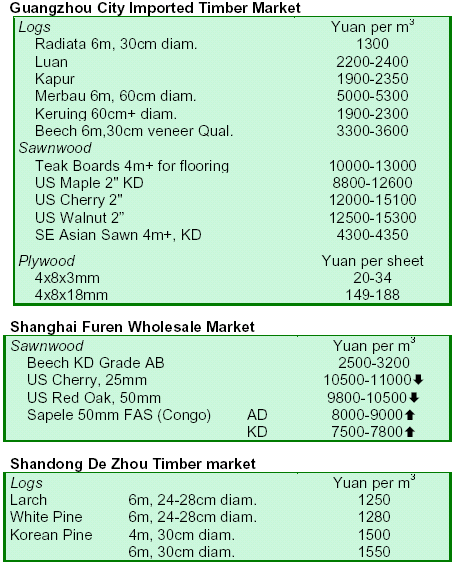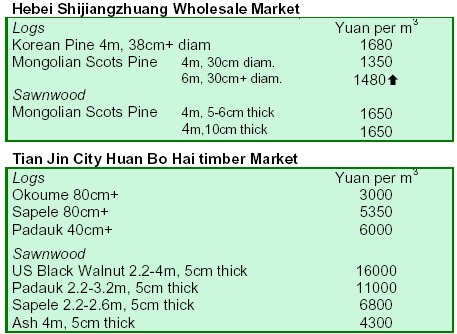US
Dollar Exchange Rates of 15th Dec.
2007
China Yuan
7.371
Report from China
MOC revises guidance on foreign investment enterprises
The Ministry of Commerce and the National Development and Reform Commission recently
updated guidance for industries receiving foreign investment. The new guidance
was approved by the state council and took effect on 1 December 2007 in place of the guidance drawn up in
2004. The guidance explains investments that are ¡®encouraged¡¯, ¡®restricted¡¯ and ¡®prohibited¡¯.
Primary changes have been made to the ¡®restricted¡¯ and ¡®prohibited¡¯ categories.
Regarding those changes that have been made to the ¡®encouraged¡¯ list, advanced technologies
that China has mastered and are competent in production capacity will not be ¡®encouraged¡¯ in
the new guidelines, although ¡®service-outsourcing and modern logistics¡¯ will be added.
Foreign Direct Investment dedicated to clean production capacity, renewable energy and ecological
protection are also ¡®encouraged¡¯. On the other hand, foreign capital is
¡®prohibited¡¯ from being used in the exploration of rare and non-reproducible resources, or in high consuming and
polluting industries. Foreigners are also ¡®prohibited¡¯ from investing in China¡¯s golf courses,
gambling services and ammunitions manufacturing. The government is ¡®restricting¡¯ foreign capital flows to the development of
large-scale property investments and construction and operation of high-end hotels, villas, office towers, and
exhibition malls. Certain ¡®restrictions¡¯ also apply to investments going to housing agents, brokerages and
second-tier real estate markets.
The revised guidelines drop ¡®restrictions¡¯ on the limit of foreign investment in the central and
western regions of China, in an effort to detract attention from investments in
coastal areas. Such changed guidelines are also being considered in order to rejuvenate Northeast China and
other historical industrial bases.
Interest grows in China¡¯s wood veneer industry
Due to rising market demand, China¡¯s wood veneer industry holds great promise. The value of
China¡¯s wood veneer exports in 2006 totaled USD171 million, a year on year increase of 33.6%.
Wood veneer is increasingly popular as decorative face of furniture, solid composite
flooring and wooden doors in the international and domestic markets. The value of China¡¯s furniture output in
2006 grew 27% to USD17.4 billion. Of the total, the value of wooden furniture exports rose
39.4% to USD8.78 billion. The output of China¡¯s wooden flooring in 2006 reached 330 million
m2. Of the total, the output of solid composite flooring was 60 million m2. The value of
China¡¯s wooden door output in 2006 grew 33.3% to RMB 32 billion yuan (about USD4.3 billion). It is
expected that the total value of China¡¯s wooden door output will exceed RMB40 billion (about
USD5.4 billion) by the end of 2007, and the value of door exports will reach USD700 million.
Local experts think that the local wood veneer industry will have a bright future in tandem with
the development of furniture, solid composite flooring and wooden doors.
Guangxi Province sees rapid development of plywood industry
China¡¯s Guangxi Province has been listed as a key national area for fast growing and high
yielding plantation bases. As a result, the Province has had the advantage of
building a booming plywood industry in which the number of plywood enterprises has increased nearly tenfold, from
39 in 2000 to 400 in 2007. By the end of 2006, the capacity of Guangxi plywood production
reached 2.8 million m3 with a value of RMB2.8 billion yuan (about USD3.8 million). The plywood
industry has helped to rapidly develop Guangxi¡¯s forest industry.
In order to guarantee supply of raw materials, many plywood enterprises establish their own
forest plantations. The rapid development of the Guangxi plywood industry has also driven the
development of afforestation, logging, and transportation initiatives. In addition, the development
of the plywood industry also provides employment opportunities, increases farmers¡¯ income and promotes the
development of the regional economy.
Guangxi is one of the regions that have fast growing and high yielding plantation bases. At
present, there are 220 million hectares of forested land, of which 60% is commercial forest land. Guangxi¡¯s plywood industry is
expected to reach a production capacity of 5 million m3, generate RMB 6 billion yuan (about USD815 million) of
sales, and create USD 100 million of foreign exchange.
Plywood mill adds another 100,000 m3 to production capacity
Guangxi Shanghua Forestry Co., Ltd. added a new plywood mill to increase its annual output to 100,000 m3
in its Shangsi County operations. The company built its operations in September
2006, with an aim to integrate forest plantation bases with plywood production facilities.
The company has invested about USD100 million, of which USD60 million was used to build a fast
growing and high yielding eucalyptus plantation and USD40 million was dedicated to building a
new plywood mill. The new mill has the capacity to produce a total output of
17,000 m2 of rotary veneer and 28,000 m2 of plywood. Fourteen peeling lathes, 17 pre-pressers, and 15 hot
presses and 7 sanders have been installed in the new mill. The main products of the mill are plywood,
decorative veneer, flooring materials and package materials. The company also has the largest
eucalyptus plywood mill, which produces different kinds of panels and advanced
equipment.
China is focus of Chilean wood products exports
According to statistics from China¡¯s national customs agency, Chile exported 830,300 tons of
pulp and paper to China during the first three quarters of 2007 valued at USD554 million. The
statistics show the value of Chilean wood products to China rose to USD600 million, but
Chile¡¯s exports to the US fell to USD613 million in the first three quarters of 2007. It had been reported
that 18.3% of Chile¡¯s wood products were exported to the US and 15.8% to China. Chile¡¯s wood products exports to
China rose 30% in the first nine months of 2007. Local experts note that China would exceed the US¡¯s import of
Chilean wood products if the current rate of growth continues.


|